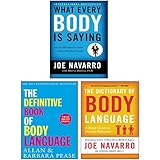As an Amazon Associate we earn from qualifying purchases.
The Dictionary of Body Language: A Field Guide to Human Behavior by Joe Navarro serves as a practical guide to understanding nonverbal communication. Navarro, a former FBI agent, draws on his expertise in behavioral analysis to provide readers with insights into human behavior through the subtle signs and signals displayed by the body. This review explores the book’s structure, the depth of content, practical applications, and its unique approach to the study of body language, assessing its value as a resource for both professionals and general readers interested in understanding nonverbal cues.
- Joe Navarro (Author)
- English (Publication Language)
- 208 Pages – Generic (Publisher)
- Joe Navarro (Author)
- English (Publication Language)
- 874 Pages – 04/10/2023 (Publication Date) – William Morrow Paperbacks/Mira Ltd (Publisher)
Overview of Content
The book is structured in dictionary format, organizing over 400 body language behaviors alphabetically, which makes it a user-friendly reference for those interested in quickly looking up specific gestures or expressions. Each entry provides a detailed explanation of the behavior, often including Navarro’s interpretations and examples drawn from real-life scenarios. The format allows readers to dive into any particular section or read sequentially to gain a comprehensive understanding of human nonverbal behaviors. Navarro’s insights cover a range of topics, from common gestures like crossed arms or averted gaze to more nuanced actions like micro-expressions and posture changes.
This design choice makes it distinct from many other body language guides, which typically present body language analysis in narrative or categorical form. Navarro’s dictionary-style approach simplifies the process of finding information on specific gestures and behaviors, making it a practical tool for readers looking for quick, applicable insights.
Depth and Breadth of Behavioral Insights
One of the book’s primary strengths lies in the depth of Navarro’s expertise in behavior analysis. Each entry not only defines the gesture but also examines the possible meanings behind it, accounting for context, individual differences, and cultural variations. For instance, Navarro explains that while crossed arms can indicate defensiveness, they may also simply be a resting position for comfort in a cold environment. This layered analysis helps readers avoid common pitfalls of over-interpreting isolated behaviors and encourages a more nuanced understanding.
Navarro goes beyond merely describing behaviors by linking them to the psychology behind human instincts and evolutionary biology. He explains that many behaviors, such as mirroring or leaning in, are rooted in primal survival mechanisms and social bonding. This adds depth to the book, offering readers insight into the “why” behind the behaviors and making it a resource for understanding human motivations, not just surface-level actions.
Practical Applications
The book is particularly valuable for professionals in fields requiring high-level interpersonal skills, such as law enforcement, sales, therapy, and negotiation. Navarro’s FBI background gives him a unique perspective on behaviors that may signify discomfort, deception, or aggression, which can be critical in high-stakes situations.
For general readers, the book provides a roadmap to better interpersonal relationships, offering tools to read subtle cues that can indicate interest, discomfort, or connection. For example, understanding that prolonged eye contact often signals confidence can be useful in social or professional contexts where interpreting another’s confidence level can inform one’s response. Additionally, recognizing signs of disengagement, like shifting weight or glancing at the exit, may help individuals steer conversations more effectively.
One key aspect Navarro emphasizes is the importance of context in interpreting body language. He advises readers not to jump to conclusions based on a single gesture but rather to look for clusters of behaviors and situational cues that clarify intent. This advice is particularly valuable in avoiding misunderstandings and stereotypes, reinforcing that body language should be read as part of a broader context, not in isolation.
Strengths of the Book
- Expertise and Credibility: Navarro’s extensive career with the FBI and his expertise in behavioral analysis lend credibility to his interpretations and recommendations. Readers can feel confident that the insights are grounded in real-world application rather than speculative or anecdotal observations.
- Accessibility and Usability: The dictionary format is intuitive, making it accessible for users who may not have time to read an entire book sequentially. This layout is ideal for professionals and casual readers alike, as it allows users to locate relevant behaviors quickly.
- Psychological and Biological Context: Navarro’s explanations delve into why certain behaviors exist from a psychological and evolutionary standpoint, which deepens readers’ understanding and adds a layer of scientific rigor to the observations.
- Avoidance of Over-Simplification: Unlike many body language books, The Dictionary of Body Language avoids the common pitfall of assuming all gestures have one specific meaning. Navarro emphasizes the significance of clusters of behaviors, the role of context, and individual variability, making the book a more accurate and sophisticated guide to nonverbal communication.
Criticisms and Limitations
Despite its strengths, The Dictionary of Body Language does have some limitations. One of the primary criticisms is that the dictionary format, while user-friendly, may not provide the narrative depth that some readers expect from a book on body language. The alphabetical arrangement might feel fragmented for those seeking a more cohesive exploration of nonverbal communication theories and principles.
Additionally, while the book covers a wide range of behaviors, it does not deeply address cultural differences in body language. Though Navarro occasionally mentions that certain behaviors may differ in meaning across cultures, the book predominantly focuses on a Western framework. This can limit its application in multicultural settings, where gestures and expressions may convey different meanings.
Another limitation lies in the absence of illustrations. Given the visual nature of body language, diagrams or images of certain gestures could have enhanced the book’s clarity, especially for readers new to the study of nonverbal cues. While Navarro’s descriptions are detailed, visual aids would have provided added value for readers looking to grasp more subtle nuances in body language.
Relevance in Today’s World
In an increasingly digital world where face-to-face interaction is often limited, the ability to interpret body language is more important than ever. As social interactions resume in person, the need to understand others’ nonverbal cues can aid in navigating personal and professional relationships. Navarro’s book is a valuable asset in a time when people may feel out of practice in reading body language after extended periods of remote communication.
For professionals, particularly in law enforcement, sales, and counseling, the book offers guidance on how to read body language cues that may reveal a client’s or suspect’s emotions and intentions, potentially informing critical decisions. Furthermore, for anyone looking to strengthen their empathy and social awareness, Navarro’s insights provide a solid foundation for recognizing and interpreting the often subtle signals that can shape interpersonal connections.
Summary
The Dictionary of Body Language by Joe Navarro stands out as a practical and insightful guide to understanding human behavior through nonverbal communication. Its dictionary-style format offers easy access to over 400 behaviors, making it an invaluable tool for both quick reference and comprehensive study. While the book’s lack of illustrations and cultural focus may limit its scope slightly, Navarro’s depth of expertise and attention to context make it an authoritative resource on body language.
Overall, Navarro’s guide offers readers an approachable and detailed manual for navigating the complexities of nonverbal communication. From practical applications in the workplace to improving personal relationships, The Dictionary of Body Language equips readers with the knowledge to decode the silent language of the human body effectively. Whether you are a professional seeking to refine your interpersonal skills or simply a curious reader, Navarro’s book provides a well-rounded introduction to the world of body language.
Last update on 2025-04-05 / Affiliate links / Images from Amazon Product Advertising API



